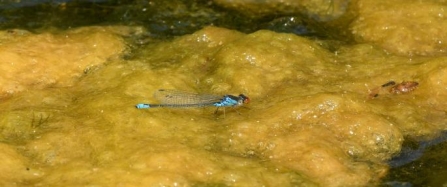John Foster was the first to find Small Red-eyed Damselflies (Erythromma viridulum) at a series of duck ponds at Roskilly’s Tregellast Barton Farm, St Keverne. Up until now, no records of this species have ever been confirmed in Cornwall, as this species has a south-easterly distribution in the UK. Realising the importance of this sighting, he got in touch with several local recorders including the county recorder for birds, David Parker.
Dave immediately went to take a look for himself and, after a bit of searching, spotted several of the damselflies at two of the ponds. He went online to submit his sightings on Cornwall Wildlife Trust’s recording site www.orks.org.uk and ERCCIS staff were able to verify the record from his photographs, making this the first record for Cornwall.
The dragonfly county recorder for West Cornwall, Adrian Eggett says,
“Wonderful news to hear of a first ever confirmed sighting of the Small Red-eyed Damselfly in Cornwall, a really exciting discovery. Like all migrant species, they’ve probably been assisted in their appearance in Cornwall by air currents from the South-east of England where they have colonised many areas of that part of the UK. Being such a small damselfly, they can be extremely difficult to see and mistaken for the slightly larger Red- eyed Damselfly, although this species too is unknown in Cornwall. It would be great if anymore sightings could be confirmed elsewhere in Cornwall, and I would urge people to keep a lookout for this magnificent damselfly and if possible provide photographic evidence.”
Dave Parker agrees,
“I suspect that as there are at least six individuals present, that they have colonised from Devon and that there are other populations in between as yet undiscovered. Even though I had been told that they were present and I was actively looking for them, it was surprisingly difficult to find any at first. It would have been all too easy to overlook them with a casual check. Hopefully now they are firmly on the radar other pockets will be found.”

